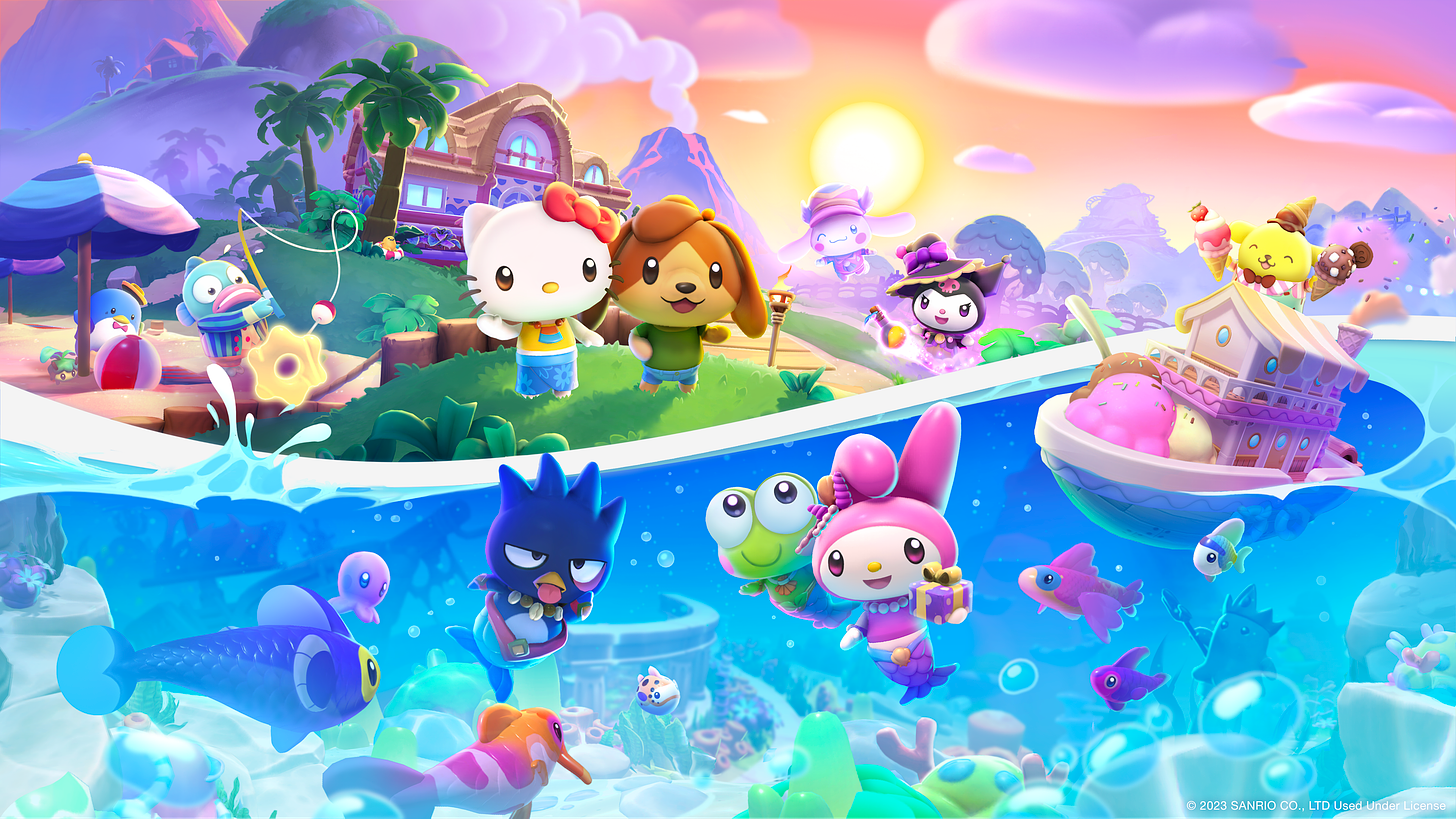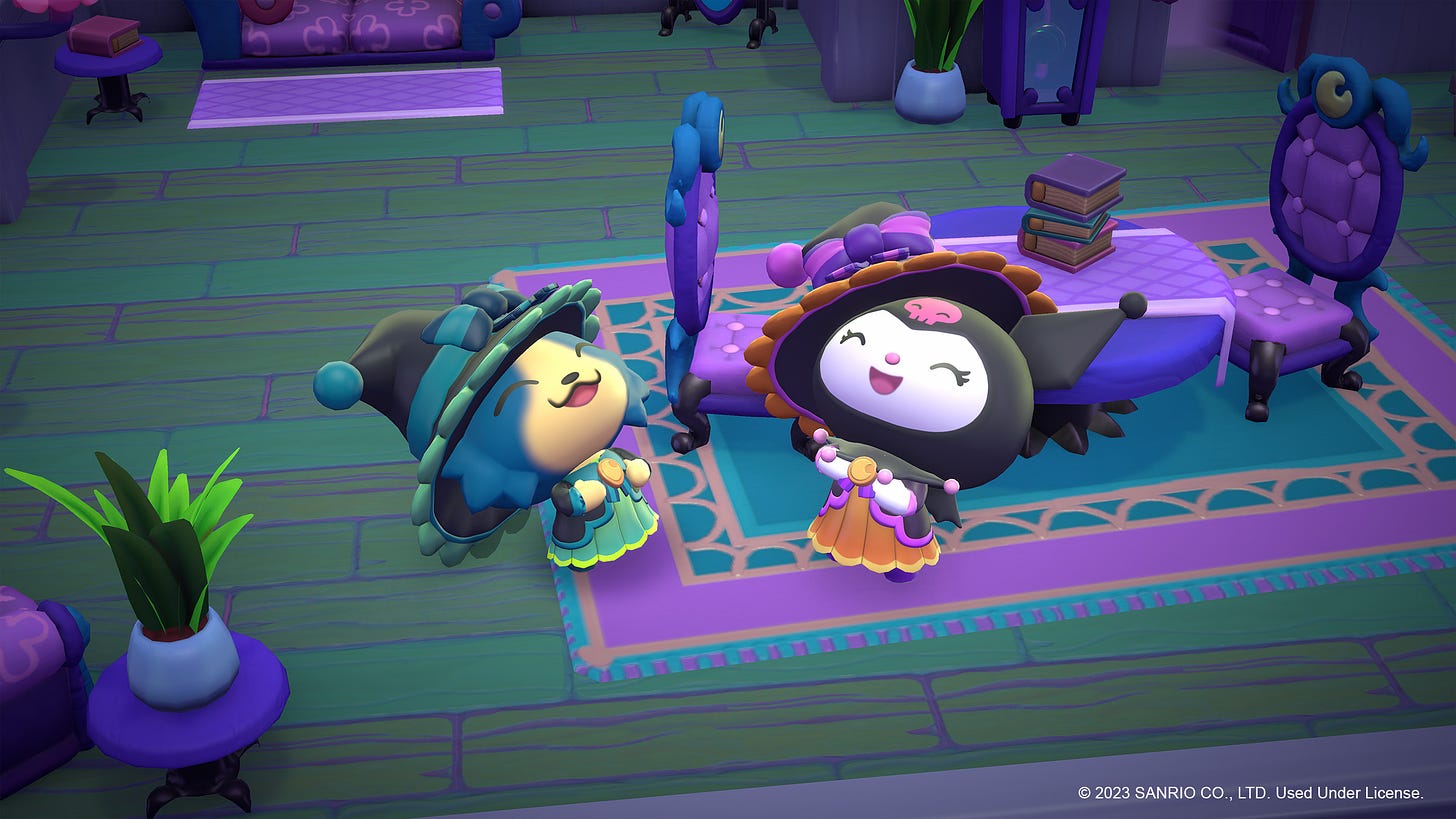The New Hello Kitty Game Uses Kindness (And Apple's Money) to Avoid Exploiting Players
Mobile games have earned cynicism and skepticism from players, a concern that weighs even heavier when kids are involved.
There was a specific moment when I realized Hello Kitty Island Adventure was more than some adorable Hello Kitty paint tossed onto a game that played like Nintendo’s Animal Crossing. A few minutes into the game, my character started climbing a mountain, and a stamina meter that looked suspiciously like the one in Breath of the Wild appeared out of nowhere. What’s a stamina meter doing in a Hello Kitty game?
“I think the open world adventure aspects are actually going to take quite a few people by surprise,” said Chelsea Howe, chief product officer at Sunblink, the developer behind the recently launched Hello Kitty Island Adventure. “For us, it was neon lights obvious. But as we've started showing it to people, people are expecting an Animal Crossing reskin. This is not that.”
Hello Kitty Island Adventure, which became available last week on Apple Arcade, does not shy from its influences. If you’re a fan of Animal Crossing, there’s a lot to like. And if you wished Animal Crossing had more “game” elements to it, you’re really going to find a lot to like about Hello Kitty Island Adventure. That’s where the open world elements, and surprising influence from a game like Breath of the Wild, comes in.
Every time my oldest sees a clip from Animal Crossing, she claims she wants to try it, but each time we’ve tried something like it, the amount of reading has turned her off.
(She turns seven at the end of this month, and while reading and comprehension is coming along, it’s been a struggle, and is often the primary reason we don’t play some games. I’m very curious to see what happens with her media habits when it all clicks.)
Hello Kitty Island Adventure has a lot of reading, too, and there’s no voice acting. My oldest spent roughly an hour playing the opening with me, but every time I’ve asked her if she’d like to head back, she’s turned me down. That feels unique to my child, however, and not a knock against the game, which seems exceptionally well made.
“We knew with Hello Kitty that we were going to get a kid audience as one of our as one of our groups,” said Howe, whose work in mobile games stretches all the way back to the days of FarmVille on Facebook. “That was definitely always in our mind, and part of honoring the Sanrio brand and the Hello Kitty and Friends brand is ensuring that kids can have a fantastic, safe, fun time. That was always on our radar, and definitely a part of how we did the design.”
(Side note: Howe told me a funny story about her work on FarmVille during the early 2010s. This was an era where the term “engagement” felt new, and they were trying to figure out ways of getting the game’s players more involved. They came up with the idea of creating two official Facebook fan pages: one for the cows of FarmVille, another for the game’s sheep. The plan was to hold a contest around whichever page got the most fans. Two weeks later, Facebook updated its terms of service to specifically declare that companies could not have two different fan pages. Oops.)
One of the later areas in Hello Kitty Island Adventure is the Haunted Mansion. It’s also one of the more open areas, full of rooms with surprises, puzzles, and more. What if you don’t…want to solve the puzzles? Kuromi, an imp-looking character in the Hello Kitty universe, travels with you during part. At any point, you can ask Kuromi to complete the puzzles for you. There’s no punishment. It’s just a friend helping you out.
Funnily, this option didn’t come about because of the potentially young audience that might play Hello Kitty Island Adventure. It came about because of the potentially older audience that might play the game, as Sunblink playtested during development.
“The kids would just bang on something until they figured it out and be totally fine with that,” said Howe, “and we'd have like these 35-year-old women who are like, ‘why do I have to do that?’ You don't. Just go talk to Kuromi, and it'll be okay. And, obviously, I'm part of that audience! It was very much a moment of self reflection and being like, oh, yeah, I do just—when I'm in my zen place, I just wanna zen and trying to respect that.”
The most shocking playtest response came towards the end, when some 18-year-old boys played and loved it. The love for Hello Kitty (and a well-made game) is universal!
“Creating this world that people do want to continue to engage with is business critical, essentially. But we can do that without a lot of those very explicit constraints that come with a microtransaction ecosystem. […] I think it really let us focus a lot more on creating a game about the characters at the story and the world and lower the importance of making sure the economy was tuned incredibly tightly, and that here were all of these trigger points for getting people to pay, or to want to pay, or turning them away if they didn't pay.”
The path to a well-made mobile game is not always obvious, because what defines “well-made” is in the eye of the beholder. Is the goal to make money, or something good and satisfying? Granted, this tension exists for nearly all video games, but it’s especially true in mobile, where one of the most common complaints by players is the feeling of being exploited, and a normal fear for a parent is their child getting exploited.
“Kind is one of our company values,” said Howe. “We make kind, collaborative, imaginative games, and kind is how that philosophy manifests. A lot of it that I've discovered is transparency. Being very clear with people, so they can choose whether or not they want to engage.”
Hello Kitty Island Adventure does not have microtransactions. Nintendo’s own foray into mobile Animal Crossing, Pocket Camp, is full of them. But Pocket Camp is also a free-to-play game, whereas Hello Kitty Island Adventure is a game that’s free to download—if you’re paying for an Apple Arcade subscription. By rule, Apple Arcade games can’t have advertisements or microtransactions. It’s part of the reason I’m very happy to pay my Apple Arcade subscription every month. My kids might not like every game on Apple Arcade, but it feels safe to let them play any game on the service.
“Engagement over time is still important,” said Howe. “Creating this world that people do want to continue to engage with is business critical, essentially. But we can do that without a lot of those very explicit constraints that come with a microtransaction ecosystem. That was pretty fantastic. I think it really let us focus a lot more on creating a game about the characters at the story and the world and lower the importance of making sure the economy was tuned incredibly tightly, and that here were all of these trigger points for getting people to pay, or to want to pay, or turning them away if they didn't pay. All of that just doesn't feel as good.”
Even when a game with those components is designed “well,” it never feels good, and it brings up constant friction for a parent. Roblox is the biggest offender in this regard, where every experience is filled with shiny items, weapons, and power-ups that require money to access, which means constantly fielding questions from my daughter that inevitably end with me saying “no.” It’s important for parents to set appropriate rules and boundaries, but it’s not fun to say no, and it’s especially frustrating when engaging with an experience that’s benefiting from that friction.
“For us, that's all about respecting people's time,” said Howe. “People get sick, they go on vacation, they can care about other things beside our game. And we always want coming to the game to feel positive and rewarding, and not an obligation to get stuff, or that FOMO of losing your streak—whatever it is. All of that gets wrapped up into this idea of kindness.”
This balance, like most everything in a game, has a number: 70%. Hello Kitty Island Adventure will have in-game events that come and go, but the developers won’t require players to be there every day. 70% means you showed up most of the time. Plus, even if you don’t hit the 70% threshold, the items will cycle back into the world in the future. Nothing is permanently lost. Players aren’t punished for having lives outside the game.
Most mobile games aren’t designed like this, even if they are aligned with a franchise meant to appeal to kids. It’s nice to see, and we’ll have to see if I’m able to convince my daughter to take another dive into the world of Hello Kitty Island Adventure soon.
Also:
I might start playing this game myself, and see if my kid joins me. I’ve always wanted to like the Animal Crossing games, but desired more of a structure.
Interestingly, this one is playable on the Apple TV, too. I might give that a go, because this game looks like it might feel pretty good using a controller, too.
Is Hello Kitty more of an adult thing these days? I know that it looks like a thing for kids, but the impression I got while writing this story is it casts a wide net.
Have a story idea? Want to share a tip? Got a funny parenting story? Drop Patrick an email.







I recently had to have The Talk with my 7 year old about microtransactions. He's watching Youtubers play these free to play games and was begging for them but I explained how we don't like to get games that keep making you pay money to play them. Being able to say that anything on the Apple Arcade tab of the App Store is fine, as long as the content is appropriate, has made things a lot easier.
I cant play it